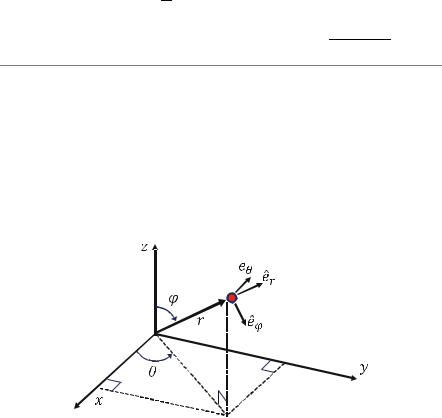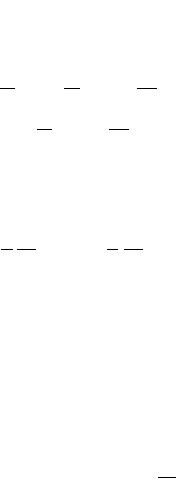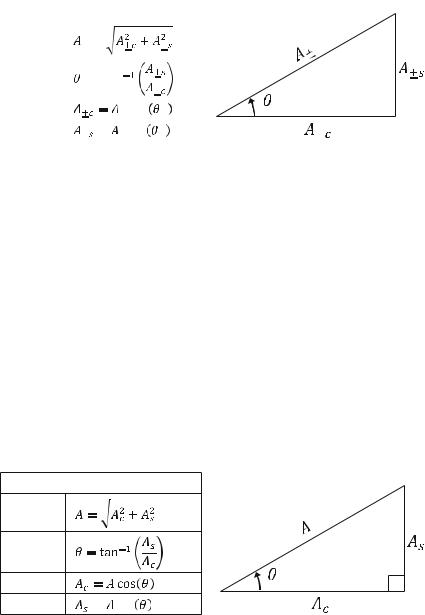
- •Preface
- •Objectives of the Book
- •Style
- •Prerequisites
- •The Big Picture
- •Contents
- •1.1 Review of Complex Numbers
- •1.2 Complex Numbers in Polar Form
- •1.3 Four Equivalent Forms to Represent Harmonic Waves
- •1.4 Mathematical Identity
- •1.5 Derivation of Four Equivalent Forms
- •1.5.1 Obtain Form 2 from Form 1
- •1.5.2 Obtain Form 3 from Form 2
- •1.5.3 Obtain Form 4 from Form 3
- •1.6 Visualization and Numerical Validation of Form 1 and Form 2
- •1.8 Homework Exercises
- •1.9 References of Trigonometric Identities
- •1.9.1 Trigonometric Identities of a Single Angle
- •1.9.2 Trigonometric Identities of Two Angles
- •1.10 A MATLAB Code for Visualization of Form 1 and Form 2
- •2.2 Equation of Continuity
- •2.3 Equation of State
- •2.3.1 Energy Increase due to Work Done
- •2.3.2 Pressure due to Colliding of Gases
- •2.3.3 Derivation of Equation of State
- •2.4 Derivation of Acoustic Wave Equation
- •2.5 Formulas for the Speed of Sound
- •2.5.1 Formula Using Pressure
- •2.5.2 Formula Using Bulk Modulus
- •2.5.3 Formula Using Temperature
- •2.5.4 Formula Using Colliding Speed
- •2.6 Homework Exercises
- •3.1 Review of Partial Differential Equations
- •3.1.1 Complex Solutions of a Partial Differential Equation
- •3.1.2 Trigonometric Solutions of a Partial Differential Equation
- •3.2 Four Basic Complex Solutions
- •3.3 Four Basic Traveling Waves
- •3.4 Four Basic Standing Waves
- •3.5 Conversion Between Traveling and Standing Waves
- •3.6 Wavenumber, Angular Frequency, and Wave Speed
- •3.7 Visualization of Acoustic Waves
- •3.7.1 Plotting Traveling Wave
- •3.7.2 Plotting Standing Wave
- •3.8 Homework Exercises
- •4.2 RMS Pressure
- •4.2.1 RMS Pressure of BTW
- •4.2.2 RMS Pressure of BSW
- •4.3 Acoustic Intensity
- •4.3.1 Acoustic Intensity of BTW
- •4.3.2 Acoustic Intensity of BSW
- •4.5.1 Issues with Real Impedance
- •4.6 Computer Program
- •4.7 Homework Exercises
- •4.8 References
- •4.8.1 Derivatives of Trigonometric and Complex Exponential Functions
- •4.8.2 Trigonometric Integrals
- •5.1 Spherical Coordinate System
- •5.2 Wave Equation in Spherical Coordinate System
- •5.3 Pressure Solutions of Wave Equation in Spherical Coordinate System
- •5.4 Flow Velocity
- •5.4.1 Flow Velocity in Real Format
- •5.4.2 Flow Velocity in Complex Format
- •5.5 RMS Pressure and Acoustic Intensity
- •5.7 Homework Exercises
- •6.1 Review of Pressure and Velocity Formulas for Spherical Waves
- •6.2 Acoustic Waves from a Pulsating Sphere
- •6.3 Acoustic Waves from a Small Pulsating Sphere
- •6.4 Acoustic Waves from a Point Source
- •6.4.1 Point Sources Formulated with Source Strength
- •6.4.2 Flow Rate as Source Strength
- •6.5 Acoustic Intensity and Sound Power
- •6.6 Computer Program
- •6.7 Project
- •6.8 Objective
- •6.9 Homework Exercises
- •7.1 1D Standing Waves Between Two Walls
- •7.2 Natural Frequencies and Mode Shapes in a Pipe
- •7.3 2D Boundary Conditions Between Four Walls
- •7.3.1 2D Standing Wave Solutions of the Wave Equation
- •7.3.2 2D Nature Frequencies Between Four Walls
- •7.3.3 2D Mode Shapes Between Four Walls
- •7.4 3D Boundary Conditions of Rectangular Cavities
- •7.4.1 3D Standing Wave Solutions of the Wave Equation
- •7.4.2 3D Natural Frequencies and Mode Shapes
- •7.5 Homework Exercises
- •8.1 2D Traveling Wave Solutions
- •8.1.2 Wavenumber Vectors in 2D Traveling Wave Solutions
- •8.2 Wavenumber Vectors in Resonant Cavities
- •8.3 Traveling Waves in Resonant Cavities
- •8.4 Wavenumber Vectors in Acoustic Waveguides
- •8.5 Traveling Waves in Acoustic Waveguides
- •8.6 Homework Exercises
- •9.1 Decibel Scale
- •9.1.1 Review of Logarithm Rules
- •9.1.2 Levels and Decibel Scale
- •9.1.3 Decibel Arithmetic
- •9.2 Sound Pressure Levels
- •9.2.2 Sound Power Levels and Decibel Scale
- •9.2.3 Sound Pressure Levels and Decibel Scale
- •9.2.4 Sound Pressure Levels Calculated in Time Domain
- •9.2.5 Sound Pressure Level Calculated in Frequency Domain
- •9.3 Octave Bands
- •9.3.1 Center Frequencies and Upper and Lower Bounds of Octave Bands
- •9.3.2 Lower and Upper Bounds of Octave Band and 1/3 Octave Band
- •9.3.3 Preferred Speech Interference Level (PSIL)
- •9.4 Weighted Sound Pressure Level
- •9.4.1 Logarithm of Weighting
- •9.5 Homework Exercises
- •10.1 Sound Power, Acoustic Intensity, and Energy Density
- •10.2.2 Room Constant
- •10.2.3 Reverberation Time
- •10.3 Room Acoustics
- •10.3.1 Energy Density due to an Acoustic Source
- •10.3.2 Sound Pressure Level due to an Acoustic Source
- •10.4 Transmission Loss due to Acoustical Partitions
- •10.4.2 Transmission Loss (TL)
- •10.5 Noise Reduction due to Acoustical Partitions
- •10.5.1 Energy Density due to a Partition Wall
- •10.5.2 Sound Pressure Level due to a Partition Wall
- •10.5.3 Noise Reduction (NR)
- •10.6 Homework Exercises
- •11.1 Complex Amplitude of Pressure and Acoustic Impedance
- •11.1.3 Transfer Pressure
- •11.2 Complex Acoustic Impedance
- •11.3 Balancing Pressure and Conservation of Mass
- •11.4 Transformation of Pressures
- •11.5 Transformation of Acoustic Impedance
- •11.7 Numerical Method for Molding of Pipelines
- •11.8 Computer Program
- •11.9 Project
- •11.10 Homework Exercises
- •12.1.1 Equivalent Acoustic Impedance of a One-to-Two Pipe
- •12.2 Power Transmission of a One-to-Two Pipe
- •12.3 Low-Pass Filters
- •12.4 High-Pass Filters
- •12.5 Band-Stop Resonator
- •12.6 Numerical Method for Modeling of Pipelines with Side Branches
- •12.7 Project
- •12.8 Homework Exercises
- •Nomenclature
- •Appendices
- •Appendix 1: Discrete Fourier Transform
- •Discrete Fourier Transform
- •Fourier Series for Periodical Time Function
- •Formulas of Discrete Fourier Series
- •Appendix 2: Power Spectral Density
- •Power Spectral Density
- •Accumulated Sound Pressure Square
- •Sound Pressure Level in Each Band
- •References
- •Index

118 |
|
|
|
|
|
|
|
|
5 Solutions of Spherical Wave Equation |
||||||||||||||||||||
|
|
|
|
|
|
|
|
|
|
|
|
|
|
|
|
|
|
||||||||||||
General forms |
Cartesian coordinates |
|
Spherical coordinates |
|
|
|
|
|
|
||||||||||||||||||||
u |
|
u ¼ |
1 |
|
p ðx, tÞ |
|
ruðr, tÞ ¼ |
|
|
A |
|
|
cos ðωt kr þ θ ϕÞ |
||||||||||||||||
|
ρo c |
|
ρo c cos ϕ |
||||||||||||||||||||||||||
pRMS |
|
|
2 |
|
|
|
|
|
|
|
2 |
|
|
|
|
|
|
|
|
|
|
|
|
||||||
p2 RMS |
A2 |
|
|
r2pRMS2 A2 |
|
|
|
|
|
|
|
|
|
|
|
|
|
||||||||||||
I ¼ pu |
I ¼ |
1 |
|
|
2 |
|
|
|
1 |
|
|
2 |
|
|
|
|
|
|
|
|
|
|
|
||||||
|
p RMS |
|
IðrÞ ¼ |
|
|
pRMS |
|
|
|
|
|
|
|
|
|
||||||||||||||
ρo c |
|
ρo c |
|
|
|
|
|
|
|
|
|
||||||||||||||||||
z |
|
p |
z |
|
ρoc |
|
|
|
|
|
|
|
|
|
|
|
cos ðωt krþθÞ |
|
|
||||||||||
¼ u |
¼ |
|
z |
¼ |
ρoc cos |
ð |
ϕ |
Þ |
|
|
|
||||||||||||||||||
|
|
|
|
|
|
|
|
|
ð |
ωt |
|
kr |
þ |
Þ |
|
|
|||||||||||||
|
|
|
|
|
|
|
|
|
|
|
cos |
|
|
θ |
ϕ |
|
|
||||||||||||
z |
|
|
See table in Chap. 4 |
|
z ¼ ρoc cos (ϕ)e jϕ |
|
|
|
|
|
|
|
|
||||||||||||||||
w |
|
w R sI(r) ds |
|
|
|
IðaÞ ¼ |
ρo c |
2 |
|||||||||||||||||||||
|
|
w RsIðrÞ ds ¼ 4πa |
2 |
|
|||||||||||||||||||||||||
|
|
|
|
|
|
|
|
|
|
|
|
|
|
|
|
|
|
|
|
|
|
|
|
|
|
|
2πA |
|
|
5.1Spherical Coordinate System
Spherical coordinates consist of three coordinates: r, θ, and φ. These denote the direct distance to a point in space, the lateral angle, and the vertical angle to get there. These three coordinates describe a point in 3D space, just as do three Cartesian coordinates x, y, and z.
The geometry of the spherical coordinates is defined below:
̂
Definition of the coordinates in spherical coordinates
When a vector is expressed in vector format, this expression is independent of the choice of the coordinate systems. A vector can be formulated in the Cartesian coordinates and the spherical coordinates as follows:
! |
|
br |
|
bθ |
|
b |
φ |
ðCartesian coordÞ |
||
v ¼ xex þ yey |
þ zez |
|
||||||||
!v |
¼ |
b |
þ |
b |
þ |
b |
ð |
Spherical coord |
Þ |
|
|
re |
|
θe |
|
ϕe |
|
|
|
||
Gradient operator is also independent of the choice of coordinate systems. The gradient operator can also be formulated in the Cartesian coordinates and the spherical coordinates as follows:
¼ |
∂ |
∂ |
∂ |
ðCartesian coordÞ |
|||
|
bex þ |
|
bey þ |
|
bez |
||
∂x |
∂y |
∂z |
|||||

5.2 Wave Equation in Spherical Coordinate System |
119 |
||||||||
¼ |
∂ |
|
1 ∂ |
1 |
∂ |
ðSpherical coordÞ |
|||
|
ber þ |
|
|
|
beθ þ |
|
∂φbeφ |
||
∂r |
r |
∂θ |
r2 sin ðθÞ |
||||||
When the acoustic field is independent of θ and φ, the gradient operator
simplifies to: |
|
|
|
|
|
¼ |
∂ |
ðCartesian coord, 1DÞ |
|||
|
|
bex |
|||
∂x |
|||||
¼ |
|
∂ |
ðSpherical coord, 1DÞ |
||
|
|
ber |
|||
∂r |
|||||
The Laplacian operator 2 can be formulated in both coordinate systems as:
|
|
|
|
2 |
|
|
|
∂2 |
∂2 |
|
|
|
|
∂2 |
|
|
|
|
ðCartesian coordÞ |
|||||||||||
|
|
|
|
¼ |
|
|
þ |
|
þ |
|
|
|
|
|
|
|
|
|||||||||||||
|
|
|
|
∂x2 |
∂y2 |
|
∂z2 |
|
|
|
|
|
||||||||||||||||||
|
∂ |
2 |
|
|
2 ∂ |
1 |
|
|
|
|
|
∂ |
∂ |
1 |
|
|
|
∂2 |
||||||||||||
2 ¼ |
|
|
þ |
|
|
|
þ |
|
|
|
|
|
sin ðθÞ |
|
|
þ |
|
|
|
|
|
ðSpherical coordÞ |
||||||||
∂r |
2 |
r |
∂r |
r2 sin |
θ |
Þ |
∂θ |
∂θ |
r2 sin |
θ |
Þ |
∂φ2 |
||||||||||||||||||
|
|
|
|
|
|
|
|
|
|
|
ð |
|
|
|
|
|
|
|
|
|
|
|
ð |
|
|
|
||||
When the acoustic field is independent of θ and φ, the Laplacian operator simplifies to:
|
2 |
¼ |
∂2 |
|
|
|
|
ðCartesian coord, 1DÞ |
|
∂x2 |
|
|
|
|
|||
|
2 |
|
∂2 |
2 ∂ |
ðSpherical coord, 1DÞ |
|||
|
¼ |
|
þ |
|
|
|
||
|
∂r2 |
r |
∂r |
|||||
5.2Wave Equation in Spherical Coordinate System
The acoustic wave equation can be formulated in the vector format as:
2 |
|
1 ∂2 |
|
|||
|
p ¼ |
|
|
|
p |
ðVector FormatÞ |
c2 |
∂t2 |
|||||
where the Laplacian operator for Cartesian coordinate and spherical coordinate is shown in the previous section. Because the vector format is independent of the choice of coordinate system, the Laplacian operator, 2, in the equation above can be formulated in both the spherical and Cartesian coordinate systems as shown in the previous section. The one-dimensional wave equation in the spherical coordinate
120 |
5 Solutions of Spherical Wave Equation |
system can be obtained by replacing the Laplacian operator in vector format in the wave equations as:
|
∂2 |
2 ∂ |
pðr, tÞ ¼ |
1 ∂2 |
|
||||||
|
þ |
|
|
|
|
|
|
pðr, tÞ |
ðSpherical coordÞ |
||
∂r2 |
r |
∂r |
c2 |
∂t2 |
|||||||
The one-dimensional acoustic wave equation in the spherical coordinate system is a function of r and t. The wave equation above can be transferred to the form of the wave equation in the Cartesian coordinate system by defining a new function ϕ(r, t):
ψðr, tÞ rpðr, tÞ
By replacing p(r, t) in the above wave equation with ψ(r, t)/r, the wave equation becomes:
∂2 |
1 |
|
∂2 |
|
||
|
ψðr, tÞ ¼ |
|
|
|
ψðr, tÞ |
ðSpherical coordÞ |
∂r2 |
c2 |
∂t2 |
||||
By comparing the wave equations in the spherical coordinate above to the wave equation in the Cartesian coordinate as shown below:
∂2 |
1 |
|
∂2 |
|
||
|
pðx, tÞ ¼ |
|
|
|
pðx, tÞ |
ðCartesian coordÞ |
∂x2 |
c2 |
∂t2 |
||||
We can see that the wave equation in the spherical coordinate is the same as the wave equation in the Cartesian coordinate. Therefore, the solutions, p(x, t), of the wave equation in the Cartesian coordinate, derived in Chap. 2, can be used as the solutions, ψ(r, t), of the wave equation in the spherical coordinate.
Example 5.1
Show that the following two equations are the same:
|
|
∂2 |
1 |
|
∂2 |
|
|
|||||
|
|
|
½rpðr, tÞ& ¼ |
|
|
|
½rpðr, tÞ& |
|||||
|
|
∂r2 |
c2 |
∂t2 |
||||||||
∂r2 |
þ r |
|
∂r pðr, tÞ ¼ c2 |
∂t2 pðr, tÞ |
||||||||
|
∂2 |
2 |
|
∂ |
1 |
|
∂2 |
|||||
Example 5.1 Solution
The Left-Hand Side
The left-hand side of the first equation becomes:

5.3 Pressure Solutions of Wave Equation in Spherical Coordinate System |
121 |
|||||
|
∂2 |
∂ |
∂ |
|
||
|
|
½rpðr, tÞ& ¼ |
|
∂r ½rpðr, tÞ& |
|
|
|
∂r2 |
∂r |
|
|||
|
¼ ∂r pðr, tÞ þ r ∂r pðr, tÞ |
|
||||
|
|
|
∂ |
|
∂ |
|
∂∂ ∂2
¼∂r pðr, tÞ þ ∂r pðr, tÞ þ r ∂r2 pðr, tÞ
∂∂2
¼2 ∂r pðr, tÞ þ r ∂r2 pðr, tÞ
The Right-Hand Side
Since r and t are independent variables, the right-hand side of the equation becomes:
1 ∂2 ½rpðr, tÞ& ¼ r 1 ∂2 pðr, tÞ c2 ∂t2 c2 ∂t2
The Combined Equation
Since the left-hand side equals the right-hand side, the original wave equation p(- r, t) can be cast as:
|
Left Hand Side ¼ Right Hand Side |
|||||||||||||||||||||||||||||
|
|
|
|
|
∂2 |
|
|
1 |
|
∂2 |
|
|
|
|
|
|
|
|
||||||||||||
|
|
|
|
|
|
|
|
½rpðr, tÞ& ¼ |
|
|
|
½rpðr, tÞ& |
||||||||||||||||||
|
|
|
|
|
∂r2 |
c2 |
∂t2 |
|||||||||||||||||||||||
! 2 |
|
|
∂ |
|
|
|
∂2 |
|
|
|
|
|
1 ∂2 |
|||||||||||||||||
|
|
|
pðr, tÞ þ r |
|
|
|
pðr, tÞ ¼ r |
|
|
|
|
|
|
pðr, tÞ |
||||||||||||||||
∂r |
∂r2 |
c2 |
∂t2 |
|||||||||||||||||||||||||||
|
|
|
∂2 |
|
|
|
2 ∂ |
|
|
|
|
|
1 ∂2 |
|||||||||||||||||
! |
|
|
|
|
pðr, tÞ þ |
|
|
|
pðr, tÞ ¼ |
|
|
|
∂t2 pðr, tÞ |
|||||||||||||||||
|
|
∂r2 |
r |
∂r |
c2 |
|||||||||||||||||||||||||
! |
|
|
∂ 2 |
þ r |
|
∂r pðr, tÞ ¼ c2 |
|
|
|
|
|
2 pðr, tÞ |
||||||||||||||||||
|
|
2 |
2 |
|
∂ |
1 |
|
∂2 |
||||||||||||||||||||||
|
|
|
|
|
|
|
|
|
|
|
|
|
|
|
|
|
|
|
|
|
|
|
|
|
|
|||||
|
|
|
|
|
∂r |
|
|
|
|
|
|
|
|
|
|
|
|
|
|
|
∂t |
|
|
|
||||||
This proves that the equation is valid.
5.3Pressure Solutions of Wave Equation in Spherical Coordinate System
Solutions of the one-dimensional wave equation in the spherical coordinate system can be formulated as a real trigonometric function, as shown below:

122 |
|
|
5 Solutions of Spherical Wave Equation |
|
rpðr, tÞ ¼ A cos ðωt kr þ θÞ |
ðREPÞ |
ð5:3Þ |
||
or: |
|
|
|
|
pðr, tÞ ¼ |
A |
cos ðωt kr þ θÞ |
ðREPÞ |
ð5:3Þ |
|
||||
r |
||||
Unlike plane waves, it is hard and unusual to create a symmetrical spherical backward or inward traveling wave. Therefore, only the forward or outward spherical waves are discussed in this course.
The following proves the outward traveling wave solution above. The wave equation in a spherically symmetric pressure field is described as:
∂2p þ 2 ∂p ¼ 1 ∂2p
∂r2 r ∂r c2 ∂t2
The spherical wave equation above can be modified and arranged into the same form as the wave equation for a plane wave. For this purpose, we will define a new function φ:
ψðr, tÞ rpðr, tÞ
Note that ψ could be either a real or a complex number, depending on the equation in which it is used. For example, if ψ is used in a complex equation, it is a complex number. Similarly, if it is used in a real equation, it is a real number.
Substituting the function ψ(r, t) into the following equation will yield the spherical wave equation. The algebra is straightforward and is not shown here, but will be assigned as an exercise:
∂2 ψðr, tÞ ¼ 1 ∂2 ψðr, tÞ
∂r2 c2 ∂t2
Since the above equation has the same form as the one-dimensional plane wave equation, it has the same solutions as shown below:
ψðr, tÞ ¼ ½A c cos ðωt þ krÞ A s sin ðωt þ krÞ&
þ½Aþc cos ðωt krÞ Aþs sin ðωt krÞ& ðRIPÞ
¼ Aþ cos ðωt kr þ θþÞ þ A cos ðωt þ kr þ θ Þ ðREPÞ
where A , A+, A c, A+c, A s, A+s, θ , and θ+ are real constants related by the following geometry relationships:

5.3 Pressure Solutions of Wave Equation in Spherical Coordinate System |
123 |
|||||||
|
|
|
|
|
|
|
||
|
Geometric Relationship |
|
|
|
||||
|
|
|
|
|
|
|
|
|
|
Geom 1 |
± = |
|
|
|
|
|
|
|
|
|
|
|
|
|
|
|
|
Geom 2 |
± = tan |
|
|
|
± |
|
|
|
|
|
|
|
|
|||
|
|
|
|
|
|
|
|
|
|
Geom 3 |
± cos |
± |
|
|
|||
|
|
|
||||||
|
|
|
|
|||||
|
|
|
|
|
|
|
|
|
|
Geom 4 |
± = ± sin |
± |
|
± |
|
|
|
Since only forward traveling wave is considered in the spherical coordinates, the above equation can be simplified by defining the following new variables:
Ac Aþc
As Aþs
A Aþ
θ θþ
Therefore, the outward traveling wave in spherical coordinates becomes:
ψðr, tÞ ¼ Ac cos ðωt krÞ As sin ðωt krÞ |
ðRIPÞ |
¼ A cos ðωt kr þ θÞ |
ðREPÞ |
where A, Ac, As, and θ are real variables related by the following geometric relationships:
Geometric Relationship
Geom 1
Geom 2 |
|
Geom 3 |
|
Geom 4 |
= sin |
Transforming the new variable ψ(r, t) back to its original form of pressure p(r, t) yields:
